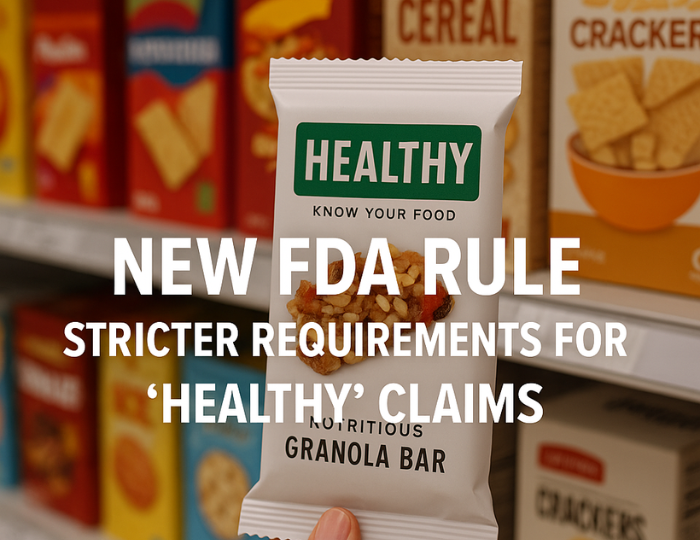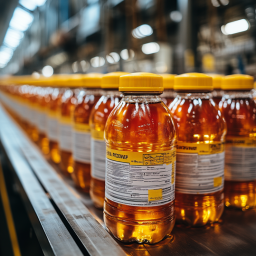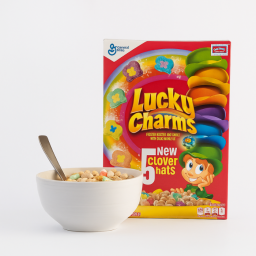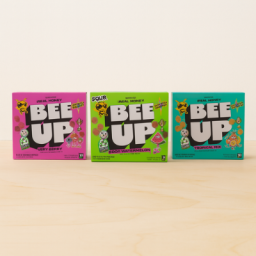
Can Your Product Still Be Labeled “Healthy” Under the FDA’s New Rule?
Short Answer: Maybe not.
The FDA has redefined what qualifies as “healthy” on food labels, introducing stricter nutritional requirements that many existing products will no longer meet. Food and beverage companies must act now to review, reformulate, and relabel products—or risk FDA penalties, product recalls, and even consumer lawsuits.
In this article, we break down everything your CPG brand, food startup, or packaged goods company needs to know to stay compliant under the new rules.
Who Must Comply with the New FDA “Healthy” Labeling Regulations?
If your business uses the term “healthy” on packaging, marketing materials, or online product listings, you must comply with the new FDA standard.
This includes:
- Front-of-package claims
- Product names referencing health
- Advertising slogans and e-commerce descriptions
Key Dates:
- Rule Finalized: April 28, 2023
- Effective Date: April 28, 2025
- Compliance Deadline: January 1, 2028
Brands have a grace period until 2028 to phase out non-compliant “healthy” claims—but early action is crucial.
What Changed with the Definition of “Healthy”?
The FDA’s previous (1994) definition mainly focused on limiting fat, but didn’t address sugar, sodium, or real nutritional value.
Today’s updated rule demands that foods offer actual health benefits based on modern nutrition science.
Major Changes:
1. Mandatory Nutrient-Dense Ingredients
Products labeled “healthy” must contain meaningful amounts of nutrient-rich foods like whole grains, fruits, vegetables, dairy, or lean proteins. Highly processed products without these ingredients may no longer qualify.
2. Strict Limits on Added Sugars
Products must now limit added sugars to 5% or less of the Daily Value (DV) per serving. Many flavored yogurts, cereals, and snacks will need reformulation.
3. Reduced Sodium Thresholds
Different food categories now have lower sodium limits. For example, snacks must not exceed 230 mg of sodium per serving.
4. Saturated Fat Restrictions
Saturated fat limits have tightened. However, beneficial fats from sources like nuts, seeds, and avocados are favored, allowing some high-fat foods to still qualify.
How Food Companies Can Stay Compliant with the New “Healthy” Labeling Rules
1. Audit Your Product Line
Evaluate each product to determine if it meets the new healthy standards. Identify which items need reformulation, labeling updates, or marketing changes.
2. Reformulate Key Products
Reduce added sugars, cut sodium content, and incorporate nutrient-dense ingredients where possible. Reformulation can be a strategic opportunity to enhance product appeal under new wellness trends.
3. Revise Labels and Marketing Materials
If a product no longer meets the updated definition, companies must remove “healthy” claims from labels, advertisements, and online listings before January 1, 2028.
4. Explore Alternative Health Claims
If the “healthy” claim is no longer an option, consider other compliant messaging, such as:
- “High in fiber” (for qualifying products)
- “Heart-healthy” (subject to specific criteria)
- “Made with whole grains” (when accurate)
Choosing alternative claims can maintain consumer trust while complying with FDA standards.
The Risks of Non-Compliance
Failing to align your branding and marketing with the new FDA guidelines carries significant legal and financial risks:
- FDA Enforcement Actions: Including warning letters, label rejections, or mandatory product recalls.
- Civil Penalties: The FTC and state AGs may pursue penalties for misleading advertising.
- Consumer Class Actions: Consumers can file lawsuits under consumer protection laws, especially around misleading “healthy” claims.
- Brand Damage: Rebuilding lost consumer trust can be far costlier than proactive compliance.
Question & Answer: What Companies Are Asking About the New FDA “Healthy” Rule
Question 1: When does the new FDA healthy labeling rule officially take effect?
Answer 1:
The rule takes effect on April 28, 2025, but companies must fully comply by January 1, 2028. Early compliance is recommended to avoid last-minute challenges.
Question 2: What happens if we don’t remove non-compliant “healthy” claims by the deadline?
Answer 2:
You could face FDA enforcement actions, including warning letters, product recalls, civil penalties, and consumer class-action lawsuits for false advertising.
Question 3: Can we use “healthy” marketing claims if only part of the product meets the requirements?
Answer 3:
No. Under the new rule, the entire product must meet the updated nutrient and ingredient criteria to qualify as “healthy.” Partial compliance won’t protect your brand.
Question 4: How can a food startup balance innovation and compliance?
Answer 4:
By involving legal counsel early during product development and marketing planning. Juris Law Group, P.C. can help startups create formulations and claims that are both compelling and compliant.
Question 5: Will products like protein bars and smoothies be affected?
Answer 5:
Yes, heavily. Many bars, smoothies, and ready-to-drink products marketed as “healthy” today exceed new limits on added sugars or sodium and will require reformulation or rebranding.
Question 6: How can Juris Law Group, P.C. help brands prepare for the new FDA rule?
Answer 6:
We review product portfolios, assist with label compliance, advise on reformulation strategies, and help brands proactively manage risk—so you stay compliant while preserving market credibility.
Final Thoughts: Don’t Let Compliance Deadlines Catch You Off Guard
The FDA’s overhaul of “healthy” labeling rules signals a major shift for food and beverage brands across the U.S. Companies that act early—by auditing products, updating marketing, and seeking expert legal counsel—can turn this regulatory change into a competitive advantage.
At Juris Law Group, P.C., we specialize in CPG legal counsel in California and nationally. Whether you’re a food startup navigating new claims or an established brand preparing for FDA label compliance, we are here to guide you every step of the way.
📩 Contact us today to ensure your products meet the FDA’s new healthy labeling standards—and to protect your brand in a rapidly evolving marketplace.














